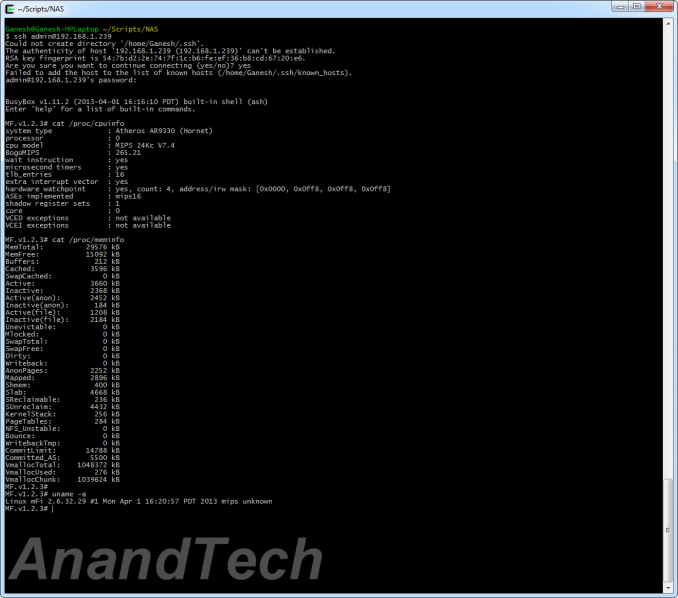Ubiquiti Networks mFi mPower Wi-Fi Power Strip Review
by Ganesh T S on November 21, 2013 3:00 AM EST- Posted in
- Home Automation
- Wi-Fi
- Ubiquiti Networks
- IoT
Inside the mPower
The mPower can be accessed and controlled via SSH even without linking it with a mFi host. In this case, the SSH login credentials are the default (ubnt/ubnt). The mPower unit runs Linux under its hood, with BusyBox providing much of the needed access functionality. The unit uses the Dropbear SSH server service. Accessing the unit over SSH gives us some insight into the core platform.
The mPower uses the Atheros AR9330 Hornet platform (more commonly found in wireless access points / low end routers such as this one) for its networking functionality and host CPU. The unit has 16 MB of RAM. The more interesting aspect is the chip used for collecting the electrical parameters. Ubiquiti takes pride in the fact that the electrical statistics are gathered by utility-grade ICs rather than the ADCs employed by other competing solutions. The mPower uses the Prolific PL7223 for gathering the electrical parameters. The PL7223 is apparently popular in these circles, as it also finds a place in GainSpan's SmartPlug kit. At this price point, it would be unfair to expect solid-state relays. So, we do have the clicking sounds when outlets are turned on or off.
FCC reports for all of Ubiquiti's products are linked on this page. We could have torn down the mPower unit ourselves, but, with the details of the platform evident from gaining SSH access, we leave it to the photographs provided in the FCC submission. They are reproduced in the gallery below.
In the next section, we will look into taking advantage of SSH for the development of custom applications.

















61 Comments
View All Comments
Hrel - Thursday, November 21, 2013 - link
Does the review even really matter? If you buy Mac products you're going to buy Mac products. IT's always the same thing and there's never any choice. Review isn't really necessary.melgross - Friday, November 22, 2013 - link
Very funny. It's sad though, if you keep buying Windows products after you buy the first one.DanNeely - Thursday, November 21, 2013 - link
Ganesh hasn't done any Apple reviews in at least at year; his review of this product has nothing to do with Anand finding time to write a review about the MBP.ydeer - Thursday, November 21, 2013 - link
With the dive in quality that the reviews on this site have taken lately, that doesn’t bother me nearly as much as it used to.I _bet_ the MBP review won't address the well documented and quite severe "yellow tint" screen issue because it won’t be there on their cherry picked review sample and "testing" the Xbox One is evidently more important than biting the hands that feed this site.
Flunk - Thursday, November 21, 2013 - link
I'll give you the gist of that review. It looks like last year's MacBook Pro, has Haswell and has better battery life, a PCIe SSD. A bit better GPU performance, almost the same CPU performance.Seriously, there are a lot of reviews out there.
stadisticado - Thursday, November 21, 2013 - link
You realize that more than one person works at Anandtech right? Its not like Anand or Brian personally reviewed this item...jason32 - Friday, November 22, 2013 - link
You're going to buy it anyway. Why bother reading reviews?edwpang - Thursday, November 21, 2013 - link
Why do I need these kind of device? . Apparently, we cannot use it to control computers. My TV and home theater receiver are just in standby which use less than 5W in total. We do need to control the lights but we need wifi-enable switch for that. What else do we need it for?alinot - Thursday, November 21, 2013 - link
I'd actually like to use it with my fish tank. There's a lot of parameters to control that run on electricity, including light, bubblers, filters, and heat that can effect the water. This matters a lot in smaller tanks especially, if one parameter goes out of whack unsupervised, your whole tank could die in a few hours. The fact that this is open source and hackable and controllable means I could implement it in my probes and measurements to automatically adjust as needed.This strikes me as a product that has more practical application in the enterprise and business environments than at home, though.
jason32 - Friday, November 22, 2013 - link
Why not use an Arduino and some peripherals if you're going to write your own code? Most of the use cases I see that require using your own custom code with these mFi products can be done with simple microcontroller boards and accessories.